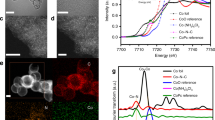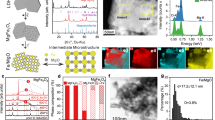Abstract
The synthesis of ammonia from hydrogen and nitrogen over a reduced iron oxide catalyst is so well known1–5 and so widely used (current world capacity is close to 100 × 106 tons per year) that it may seem surprising that the mode of operation of the catalytic remains enigmatic. That both H2 and N2 must first dissociate at the catalyst surface is beyond dispute, but there is debate as to the role of various promoters (Al, K, Ca) which greatly improve the catalytic performance when added to the precursor Fe3O4. Although it is widely accepted that regions of paracrystallinity exist within the catalyst, no one has questioned its overall crystal-linity. In this work, which entails in situ X-ray diffractometry, we provide evidence that the active catalyst contains substantial amounts of a non-crystalline phase. Without promoter, reduction of Fe3O4 in the same conditions yields only crystalline α-iron.
Similar content being viewed by others
References
Perman, E. P. Proc. R. Soc. A76, 167–174 (1905).
Bosch, C., Mittasch, A., Stern, G. & Wolf, H. German Patents (DRP) 249, 447; 258, 146 (January 1910).
Mittash, A. Adv. Catal. 2, 81–104 (1950).
Nielsen, H. Catal. Rev. Sci. Engng 23, 17–51 (1981).
Timm, B. Proc. 8th int. Congr. Catal., Berlin Vol. 1, 7 (Verlag Chemie, Berlin, 1984).
Ertl, G., Lee, S. B. & Weiss, M. Surf. Sci. 114, 527–545 (1982).
Ozaki, A. & Aika, K. in Catalysis Science and Technology Vol. 1 (eds Anderson, J. R. & Boudart, M.) (Springer, Berlin, 1981).
Ludwiczek, H. et al. J. Catal. 51, 326–337 (1978).
Borghard, W. S. & Boudart, M. J. Catal. 80, 194–206 (1983).
Spencer, N. D., Schoonmaker, R. C. & Somorjai, G. A. J. Catal. 74, 129–135 (1982).
Bozso, F., Ertl, G., Grunze, M. & Weiss, M. J. Catal. 49, 18–41 (1977); 50, 519–529 (1977).
Tennakoon, D. T. B. et al. Clay Miner. 18, 357 (1983).
Long, R. W. US Patent, 2, 483, 500–511 (1949).
Mosesman, M. A. J. Am. chem. Soc. 73, 5635–5689 (1951).
Elliot, S. R. Physics of Amorphous Materials, 32 (Longmans, London, 1984).
Ertl, G., Prigge, D., Schlogl, R. & Weiss, M. J. Catal. 79, 359–377 (1983).
Jones, W. in Characterization of Catalysts (eds Thomas, J. M. & Lambert, R. M.) 114 (Wiley, New York, 1980).
Jones, W., Schlogl, R. & Thomas, J. M. JCS chem. Commun. 464–466 (1984).
Author information
Authors and Affiliations
Rights and permissions
About this article
Cite this article
Rayment, T., Schlögl, R., Thomas, J. et al. Structure of the ammonia synthesis catalyst. Nature 315, 311–313 (1985). https://doi.org/10.1038/315311a0
Received:
Accepted:
Issue Date:
DOI: https://doi.org/10.1038/315311a0
- Springer Nature Limited
This article is cited by
-
Photocatalytic nitrogen fixation under an ambient atmosphere using a porous coordination polymer with bridging dinitrogen anions
Nature Chemistry (2023)
-
Ammonia Decomposition Enhancement by Cs-Promoted Fe/Al2O3 Catalysts
Catalysis Letters (2020)
-
Heterogeneous Fe3 single-cluster catalyst for ammonia synthesis via an associative mechanism
Nature Communications (2018)
-
Activity enhancement of cobalt catalysts by tuning metal-support interactions
Nature Communications (2018)
-
Photo-illuminated diamond as a solid-state source of solvated electrons in water for nitrogen reduction
Nature Materials (2013)





